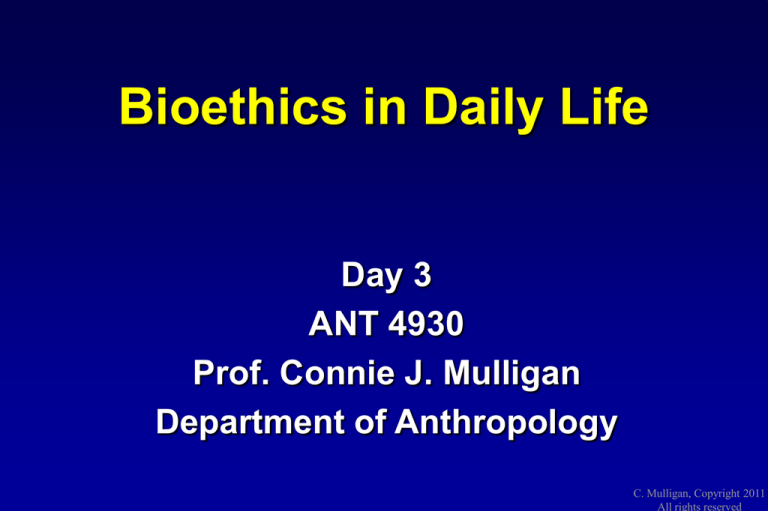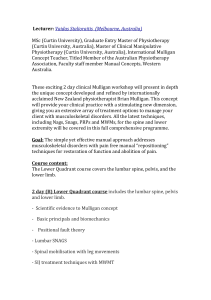
Bioethics in Daily Life
Day 3
ANT 4930
Prof. Connie J. Mulligan
Department of Anthropology
C. Mulligan, Copyright 2011
All rights reserved
This week – Genetic screening/genetic
testing and ancestry estimation
•
•
•
•
Prenatal screening
Testing for personality, mate choice, etc
Genetic ancestry testing
Reproductive technologies
–
•
Who is the mother when egg and sperm are donated?
Required reading (also listed on course webpage, Day 3)
–
–
–
–
–
–
–
http://www.newsweek.com/2010/06/09/inside-information.print.html - Newsweek article, Americans want to
know their genetic codes
http://www.technologyreview.com/blog/editors/25297/ - Genetic testing can change behavior
http://www.nature.com/ng/journal/v42/n10/pdf/ng1010-811.pdf - newborn genetic screening
http://www.nature.com/nature/journal/v466/n7308/pdf/466816a.pdf - Nature, Aug 12 2010, Genetic testing
regulation
http://www.time.com/time/magazine/article/0,9171,1158968-2,00.html – Iceland genetics project
http://www.medicalnewstoday.com/articles/157335.php - Iceland/deCODE project - genes identified to date
Skim http://bioethics.georgetown.edu/pcbe/reports/beyondtherapy/ - Beyond Therapy: Biotechnology and
the Pursuit of Happiness, report from the President’s Council on Bioethics, 2003 (353 pages)
•
Video – African American Lives
•
Four oral presentations
C. Mulligan, Copyright 2011
All rights reserved
Next week – Genetic
screening/genetic enhancement
• Eugenics
• Designer babies
• Required reading (also listed on course webpage, Day 3)
– Bioethics at the Movies (BAM)
• Chpt 5 (“No Gene for Fate?”: Luck, Harm, and Justice in Gattaca)
• Chpt 6 (Lifting the Genetic Veil of Ignorance: Is there anything really
unjust about Gattacan society?)
– http://www.scientificamerican.com/article.cfm?id=regulate-designer-babies –
Scientific American article on the need to regulate ‘designer babies’
– http://en.wikipedia.org/wiki/Eugenics - Wikipedia entry on eugenics
• Video – GATTACA
• Four oral presentations
C. Mulligan, Copyright 2011
All rights reserved
Group projects
• Group projects (10 per semester, 10 points per project, same grade
for entire group):
• Suggestions for successful group projects:
– Limit yourselves to one main point, or at the most two related points, to be
included in your projects. Resist the impulse to include all information
relevant to your topic. Instead choose the one, or two, pieces of information
that best support or explain your point.
– I think 5 minutes is sufficient time for the sort of projects and presentations I
have in mind. Thus, I am modifying the original description of 5-10 min
presentations to 5 min presentations.
• Grading criteria:
–
–
–
–
–
–
Explicit statement of question or problem – 2 points
Explicit statement of answer or position – 2 points
Inclusion of scientific information to support your point – 2 points
Clear evidence of critical thinking in presentation of your position – 2 points
Use of visual aids to enliven project/talk – 1 point
Proper citation of sources – 1 point
C. Mulligan, Copyright 2011
All rights reserved
Oral presentations
• Oral presentations (4 per semester, 25 points per presentation,
individual grade for presenter):
• Suggestions for successful oral presentations:
– Practice the entire presentation. Practice more than once. It’s only 5 min so it
doesn’t take that much time to practice it. You may think that your
presentation will be better if it is ‘fresh’, ad libbed, extemporized, etc, but you
would be wrong. Nothing beats a talk that is smooth and polished. Practicing
makes you work on your wording for each slide. Practicing also forces you to
think about how much time you spend on each slide and each bit of
information, i.e. there should be balance in terms of how much time you
spend on each point. Finally, practicing ensures that your talk is the correct
length.
• Grading criteria:
– Practiced presentation, e.g. you have something to say about each slide,
wording has clearly been worked out prior to class, you refer to
slides/figures/etc when making particular points, etc – 15 points
– Professional and polished presentation, e.g. stand and face the class, make
eye contact with class members, etc – 5 points
– Speak for correct length of time, i.e. 5 min and no more than a couple
minutes longer – 5 points
C. Mulligan, Copyright 2011
All rights reserved
Day 3
•
•
•
•
Prenatal screening
Testing for personality, mate choice, etc
Genetic ancestry testing
Reproductive technologies
– Who is the mother when egg and sperm are
donated?
C. Mulligan, Copyright 2011
All rights reserved
Genetic testing
• Gene tests (also called DNA-based tests), the newest and most
sophisticated of the techniques used to test for genetic
disorders, involve direct examination of the DNA molecule itself
– Other genetic tests include biochemical tests for such gene products as enzymes
and other proteins and for microscopic examination of stained or fluorescent
chromosomes.
• Genetic tests are used for several reasons, including:
– carrier screening, which involves identifying unaffected individuals who carry
one copy of a gene for a disease that requires two copies for the disease to be
expressed
– preimplantation genetic diagnosis
– prenatal diagnostic testing
– newborn screening
– presymptomatic testing for predicting adult-onset disorders such as Huntington's
disease
– presymptomatic testing for estimating the risk of developing adult-onset cancers
and Alzheimer's disease
– confirmational diagnosis of a symptomatic individual
– forensic/identity testing
C. Mulligan, Copyright 2011
All rights reserved
Genetic testing for CF
• Lots of variants (>1500 variants) – which to test for???
–
–
–
–
–
–
49% F508/ F508
21% F508/common mut, not F508 (3 multiplex PCRs)
21% F508/rare mut
4.5% common mut, not F508/rare mut
2.25% homozygote - common mut, not F508
2.25% rare mut/rare mut
• Screen for F508
– How many individuals w/ at least 1 copy of F508 detected?
– How many CF patients detected?
• Screen for F508 and other common muts
– How many individuals w/ at least 1 copy of F508 or common
mut detected?
– How many CF patients detected?
C. Mulligan, Copyright 2011
All rights reserved
Genetic testing for CF
• Lots of variants (>900 variants) – which to test for???
–
–
–
–
–
–
49% F508/ F508
21% F508/common mut, not F508 (3 multiplex PCRs)
21% F508/rare mut
4.5% common mut, not F508/rare mut
2.25% homozygote - common mut, not F508
2.25% rare mut/rare mut
• Screen for F508
– How many individuals w/ at least 1 copy of F508 detected?
• 91% so F508 screen will ID majority of CF patients or carriers
– How many CF patients detected?
• Screen for F508 and other common muts
– How many individuals w/ at least 1 copy of F508 or common
mut detected?
– How many CF patients detected?
C. Mulligan, Copyright 2011
All rights reserved
Genetic testing for CF
• Lots of variants (>900 variants) – which to test for???
–
–
–
–
–
–
49% F508/ F508
21% F508/common mut, not F508 (3 multiplex PCRs)
21% F508/rare mut
4.5% common mut, not F508/rare mut
2.25% homozygote - common mut, not F508
2.25% rare mut/rare mut
• Screen for F508
– How many individuals w/ at least 1 copy of F508 detected?
• 91% so F508 screen will ID majority of CF patients or carriers
– How many CF patients detected?
• 49%
• Screen for F508 and other common muts
– How many individuals w/ at least 1 copy of F508 or common
mut detected?
C. Mulligan, Copyright 2011
– How many CF patients detected?
All rights reserved
Genetic testing for CF
• Lots of variants (>900 variants) – which to test for???
–
–
–
–
–
–
49% F508/ F508
21% F508/common mut, not F508 (3 multiplex PCRs)
21% F508/rare mut
4.5% common mut, not F508/rare mut
2.25% homozygote - common mut, not F508
2.25% rare mut/rare mut
• Screen for F508
– How many individuals w/ at least 1 copy of F508 detected?
• 91% so F508 screen will ID majority of CF patients or carriers
– How many CF patients detected?
• 49%
• Screen for F508 and other common muts
– How many individuals w/ at least 1 copy of F508 or common mut detected?
• 97.75%
– How many CF patients detected?
C. Mulligan, Copyright 2011
All rights reserved
Genetic testing for CF
• Lots of variants (>900 variants) – which to test for???
–
–
–
–
–
–
49% F508/ F508
21% F508/common mut, not F508 (3 multiplex PCRs)
21% F508/rare mut
4.5% common mut, not F508/rare mut
2.25% homozygote - common mut, not F508
2.25% rare mut/rare mut
• Screen for F508
– How many individuals w/ at least 1 copy of F508 detected?
• 91% so F508 screen will ID majority of CF patients or carriers
– How many CF patients detected?
• 49%
• Screen for F508 and other common muts
– How many individuals w/ at least 1 copy of F508 or common mut detected?
• 97.75%
– How many CF patients detected?
• 72.25%
C. Mulligan, Copyright 2011
All rights reserved
Genetic testing
• Gene tests (also called DNA-based tests),
the newest and most sophisticated of the
techniques used to test for genetic
disorders, involve direct examination of
the DNA molecule itself
C. Mulligan, Copyright 2011
All rights reserved
Polymerase
chain
reaction
(PCR)
= the exponential,
synthetic
amplification of
nucleic acid from a
targeted region of
the genome
Used to produce
sufficient quantities
of DNA so we can
analyze it
C. Mulligan, Copyright 2011
Genetics, Hartl andAllJones,
2000
rights reserved
Prenatal/newborn testing
Siblings born with PKU. Untreated 11 yr old boy (left) is severely retarded.
His 2 ½ yr old sister was treated from early infancy with a low-phenylalanine
diet and has normal intelligence.
C. Mulligan, Copyright 2011
Mange and Mange, 1999, Fig 1.1
All rights reserved
Pre-implantation genetic screening
• Hormone treatment to
stimulate ovulation of
multiple eggs
• in vitro fertilization of
several eggs
• 1-2 cells removed from 8cell embryo
• PCR analysis
• Implantation of unaffected
embryos
Korf 2000
C. Mulligan, Copyright 2011
All rights reserved
• Get ready for flood of prenatal genetic testing
• http://www.nature.com/nature/journal/v469/n73
30/full/469289a.html
C. Mulligan, Copyright 2011
All rights reserved
Genetic ancestry
C. Mulligan, Copyright 2011
All rights reserved
Measuring genetic ancestry of individuals
• Ancestry informative markers
– Polymorphisms that exhibit large frequency
differences between populations, possibly different
‘racial’ groups
– In Panel b, short alleles indicate increased probability
of African ancestry
Jobling et al. 2004, Fig 15.6
C. Mulligan, Copyright 2011
All rights reserved
Detecting and measuring admixture
• You can use allele
frequencies in ancestral
populations to calculate
admixture in a completely
linear way
Jobling et al. 2004
C. Mulligan, Copyright 2011
All rights reserved
STRUCTURE analysis to determine ancestry
proportions of individual populations
Three possible parental populations
Orange = African component
Blue = Asian component
Yellow = European components
C. Mulligan, Copyright 2011
All rights reserved
Individual ancestry estimates
• Triangle plot displays ancestry
proportions from three putative
parental populations
– 100 Alu markers provide much better
resolution of individual ancestry
estimates
Jobling et al. 2004, Fig 9.5
C. Mulligan, Copyright 2011
All rights reserved
STRUCTURE
Sample of 87 Puerto Ricans
No info on unadmixed/ancestral pops
Overall proportion of membership of the
sample in each of the 3 clusters
Inferred Clusters
1
2
3
0.340 0.302 0.358
C. Mulligan, Copyright 2011
All rights reserved
Does genetic ancestry cluster geographically?
• Map shows location of
population samples
• Graph shows distribution of
genetic ancestry in African,
Asian and European
populations
Serre and Paabo 2004
C. Mulligan, Copyright 2011
All rights reserved
What if you collect more samples?
The geographic distinction disappears!!
Serre and Paabo 2004
C. Mulligan, Copyright 2011
All rights reserved
Americans want to know about
their genetics
• Would you want to know something about
your genetic ancestry?
C. Mulligan, Copyright 2011
All rights reserved
Americans want to know about
their genetics
• Would you want to know something about
your genetic ancestry?
– Why?
– What did you think of the genetic ancestry report?
C. Mulligan, Copyright 2011
All rights reserved
Americans want to know about
their genetics
• Would you want to know something about
your genetic ancestry?
– Why?
• Would you want to know something about
your genetic predisposition for disease?
C. Mulligan, Copyright 2011
All rights reserved
Americans want to know about
their genetics
• Would you want to know something about
your genetic ancestry?
– Why?
• Would you want to know something about
your genetic predisposition for disease?
– If yes, would it have to be a disease with a cure?
C. Mulligan, Copyright 2011
All rights reserved
Americans want to know about
their genetics
• Would you want to know something about
your genetic ancestry?
– Why?
• Would you want to know something about
your genetic predisposition for disease?
– Would it have to be a disease with a cure?
– Would the disease risk have to be substantial, e.g.
greater than 50%?
C. Mulligan, Copyright 2011
All rights reserved
Americans want to know about
their genetics
• Would you want to know something about your
genetic ancestry?
– Why?
• Would you want to know something about your
genetic predisposition for disease?
– Would it have to be a disease with a cure?
– Would the disease risk have to be substantial, e.g. greater
than 50%?
– What if the disease risk were only 5%?
C. Mulligan, Copyright 2011
All rights reserved
Americans want to know about
their genetics
• Would you want to know something about your
genetic ancestry?
– Why?
• Would you want to know something about your
genetic predisposition for disease?
– Would it have to be a disease with a cure?
– Would the disease risk have to be substantial, e.g. greater
than 50%?
– What if the disease risk were only 5%?
– Does it matter if the information comes from your doctor or
a commercial testing company?
C. Mulligan, Copyright 2011
All rights reserved
Americans want to know about
their genetics
• Would you want to know something about your
genetic ancestry?
– Why?
• Would you want to know something about your
genetic predisposition for disease?
– Would it have to be a disease with a cure?
– Would the disease risk have to be substantial, e.g. greater
than 50%?
– What if the disease risk were only 5%?
– Does it matter if the information comes from your doctor or
a commercial testing company?
– What would you do with this information?
C. Mulligan, Copyright 2011
All rights reserved
How to read a journal article
C. Mulligan, Copyright 2011
All rights reserved
Parts of an article
– some of this information is very field-specific and
may not be true outside Bioanthropology
•
•
•
•
What is an abstract?
What information goes into an Intro?
What information goes into Results?
What information goes into Disc?
C. Mulligan, Copyright 2011
All rights reserved
Parts of an article
• What is an abstract?
– A summary of points presented in skeletal form
– Opportunity for authors to specify what they think
are the most important points
• What information goes into an Intro?
• What information goes into Results?
• What information goes into Disc?
C. Mulligan, Copyright 2011
All rights reserved
Parts of an article
• What is an abstract?
• What information goes into an Intro?
– Background info
– Foreshadows Discussion
– All Intro material should be followed up later in article
• What information goes into Results?
• What information goes into Disc?
C. Mulligan, Copyright 2011
All rights reserved
Parts of an article
• What is an abstract?
• What information goes into an Intro?
• What information goes into Results?
– Just Results
– No interpretation, no discussion
• What information goes into Disc?
C. Mulligan, Copyright 2011
All rights reserved
Parts of an article
•
•
•
•
What is an abstract?
What information goes into an Intro?
What information goes into Results?
What information goes into Disc?
– Interpretation and significance of results
– Opportunity for authors to focus on what they think is
most important about their results
– Should pick up on info in Intro
– Can be very dependent on what topics are currently
‘hot’ so Discussion can become outdated even if
Results are still relevant
C. Mulligan, Copyright 2011
All rights reserved
How to read a journal article
• Note year of publication
– Anything more than 5 yrs old is fairly old in my field
• Note authors
– Have you read anything else by this lab?
– Author et al. Year is the best way to refer to a paper
• Refer to articles this way in Questions/Comments, Journal Analysis,
exam, etc
• General strategy for an article outside of your field
– Read Abstract, then Intro and then Disc
– M&M is usually too complicated unless you want a specific
piece of info
– Results is generally pretty cut and dried
– Re-read abstract after you read paper
• See what authors presented as the take-home message
C. Mulligan, Copyright 2011
All rights reserved
How to remember and
understand a journal article
• Take notes while reading
• Re-read article until you really understand it
• Make summary notes when you are finished reading
–
–
–
–
–
What was purpose of study?
What questions were being asked?
What were final answers?
What was unique about the study?
What is the next step?
• Write notes on paper itself or on notecards or
electronically
C. Mulligan, Copyright 2011
All rights reserved








